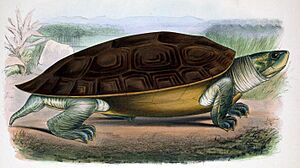Northern river terrapin facts for kids
Quick facts for kids Northern river terrapin |
|
|---|---|
 |
|
| Conservation status | |
| Scientific classification | |
| Genus: |
Batagur
|
| Species: |
baska
|
| Synonyms | |
|
click to expand
Emys baska Gray, 1830
Emys batagur Gray, 1831 Testudo baska Gray, 1831 Trionyx (Tetraonyx) cuvieri Gray, 1831 Tetronyx longicollis Lesson, 1834 Tetronyx baska Duméril & Bibron, 1835 Tetraonyx lessonii Duméril & Bibron, 1835 Tetraonyx longicollis Duméril & Bibron, 1835 Clemmys (Clemmys) batagur Fitzinger, 1835 Hydraspis (Tetronyx) lessonii Fitzinger, 1835 Emys tetraonyx Temminck & Schlegel, 1835 Tetraonyx batagur Gray, 1844 Batagur (Batagur) baska Gray, 1856 Clemmys longicollis Strauch, 1862 Tetraonyx baska Gray, 1869 Batagur batagur Lindholm, 1929 Tetraonyx lessoni Bourret, 1941 (ex errore) Batagur ranongensis Nutaphand, 1979 Batagur basca Anan'eva, 1988 (ex errore) Batagur batagur batagur Joseph-Ouni, 2004 Batagur batagur ranongensis Joseph-Ouni, 2004 |
|
The northern river terrapin (Batagur baska) is a large turtle that lives in rivers and coastal areas of Southeast Asia. It's one of the most endangered turtles in the world. Scientists believe there are only about 100 adult terrapins left in the wild as of 2018. This makes them Critically Endangered, meaning they are at a very high risk of disappearing forever.
Contents
What Does It Look Like?
The northern river terrapin is one of the biggest freshwater and brackish water turtles in Asia. It can grow up to 60 centimeters (about 2 feet) long and weigh as much as 18 kilograms (about 40 pounds).
Its shell, called a carapace, is somewhat flat. Young terrapins have a small ridge down the middle of their shell. The bottom shell, called the plastron, is large and yellowish.
The terrapin's head is quite small, with a pointy nose that turns slightly upwards. Its legs have scales that look like bands. The top of its shell and its soft body parts are usually olive-brown.
Special Colors for Breeding
During the breeding season, male terrapins get a special look. Their head and neck turn black, and the top of their head becomes crimson or orange. Their front legs also turn red or orange. Even their eye color changes! Males get yellowish-white pupils, while females have brown pupils during this time.
Where Do They Live?
The northern river terrapin is found in a few countries today. These include Bangladesh, India (in the Sunderbans), Cambodia, Myanmar, Indonesia, and Malaysia. Sadly, they have disappeared from Singapore, Thailand, and Vietnam.
These turtles love water and spend most of their time there. They live in tidal areas of river mouths, large rivers, and mangrove forests. They only come onto land to lay their eggs.
Life and Habits
Northern river terrapins are omnivorous, meaning they eat both plants and animals. They munch on plants that grow near the water and small animals like clams.
They prefer to live in freshwater. However, when it's time to breed (from December to March), they move to brackish river mouths or estuaries. Brackish water is a mix of fresh and saltwater. After laying their eggs, they return to freshwater.
These turtles are known to travel long distances, sometimes 50 to 60 miles, to reach the sandy banks where they were born. This is where they lay their own eggs. Females usually lay three groups of eggs, with each group having between 10 and 34 eggs.
Helping the Northern River Terrapin
The northern river terrapin is considered Critically Endangered by the IUCN. This means they are in great danger of becoming extinct. The main reason for this is that people have hunted them for food, including collecting their eggs.
In the past, huge numbers of these turtles were sent to fish markets in Calcutta, India. Many people there thought the river terrapin was the tastiest of all turtles. Even today, they are still illegally taken from Indonesia and sold in large numbers in China.
Besides hunting, the loss of their nesting beaches and pollution are also harming these turtles.
To help save them, special projects have been started:
- A hatchery and breeding program was set up in Bhawal National Park in Bangladesh.
- Another project is at Sajnakhali Wildlife Sanctuary in the Sunderban Tiger Reserve in India.
These efforts are supported by the Turtle Survival Alliance, an organization dedicated to saving turtles.
Types of Northern River Terrapins
Scientists recognize two main types, or subspecies, of the northern river terrapin:
- B. b. baska (named by Gray in 1831)
- B. b. ranongensis (named by Nutaphand in 1979)
See also
- Southern river terrapin



